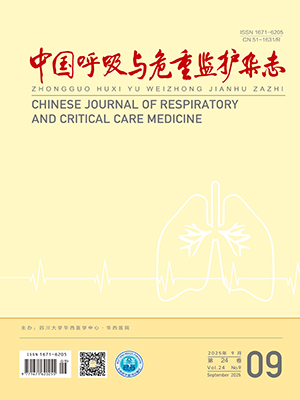| 1. |
Lv YY, Lv QR, Lv QC, et al. Pulmonary infection control window as a switching point for sequential ventilation in the treatment of COPD patients: a meta-analysis. Int J Chron Obstruct Pulmon Dis, 2017, 12: 1255-1267.
|
| 2. |
Song YL, Chen RC, Zhan QY, et al. The optimum timing to wean invasive ventilation for patients with AECOPD or COPD with pulmonary infection. Int J Chron Obstruct Pulmon Dis, 2016, 11: 535-542.
|
| 3. |
Esteban A, Ferguson ND, Meade MO, et al. Evolution of mechanical ventilation in response to clinical research. Am J Respir Crit Care Med, 2008, 177(2): 170-177.
|
| 4. |
Rochwerg B, Einav S, Chaudhuri D, et al. The role for high flow nasal cannula as a respiratory support strategy in adults: a clinical practice guideline. Intensive Care Med, 2020, 46(12): 2226-2237.
|
| 5. |
Ni YN, Luo J, Yu H, et al. Can high‐flow nasal cannula reduce the rate of reintubation in adult patients after extubation? A meta‐analysis. BMC Pulm Med, 2017, 17(1): 142.
|
| 6. |
中华医学会呼吸病学分会慢性阻塞性肺疾病学组. 慢性阻塞性肺疾病诊治指南(2013年修订版). 中华结核和呼吸杂志, 2013, 36(4): 255-264.
|
| 7. |
Borg G. Perceived exertion as an indicator of somatic stress. Scand J Rehabil Med, 1970, 2: 92-98.
|
| 8. |
Osadnik CR, Tee VS, Carson-Chahhoud KV, et al. Non-invasive ventilation for the management of acute hypercapnic respiratory failure due to exacerbation of chronic obstructive pulmonary disease. Cochrane Database Syst Rev, 2017, 7: CD004104.
|
| 9. |
Hernández G, Vaquero C, Colinas L, et al. Effect of postextubation high-flow nasal cannula vs noninvasive ventilation on reintubation and postextubation respiratory failure in high-risk patients: a randomized clinical trial. JAMA, 2016, 316(15): 1565-1574.
|
| 10. |
Stéphan F, Barrucand B, Petit P, et al. High-flow nasal oxygen vs noninvasive positive airway pressure in hypoxemic patients after cardiothoracic surgery: a randomized clinical trial. JAMA, 2015, ; 313(23): 2331-2339.
|
| 11. |
Bräunlich J, Wirtz H. Nasal high-flow in acute hypercapnic exacerbation of COPD. Int J Chron Obstruct Pulmon Dis, 2018, 13: 3895-3897.
|
| 12. |
Yuste ME, Moreno O1, Narbona S, et al. Efficacy and safety of high-flow nasal cannula oxygen therapy in moderate acute hypercapnic respiratory failure. Rev Bras Ter Intensiva, 2019, 31(2): 156-163.
|
| 13. |
Lee MK, Choi J, Park B, et al. High flow nasal cannulae oxygen therapy in acute-moderate hypercapnic respiratory failure. Clin Respir J, 2018, 12(6): 2046-2056.
|
| 14. |
谈定玉, 凌冰玉, 孙家艳, 等. 经鼻高流量氧疗与无创正压通气比较治疗慢性阻塞性肺疾病合并中度呼吸衰竭的观察性队列研究. 中华急诊医学杂志, 2018, 27(4): 361-366.
|
| 15. |
Thille AW, Coudroy R, Nay MA, et al. Non-invasive ventilation alternating with high-flow nasal oxygen versus high-flow nasal oxygen alone after extubation in COPD patients: a post hoc analysis of a randomized controlled trial. Ann Intensive Care, 2021, 11(1): 30.
|
| 16. |
Fricke K, Tatkov S, Domanski U, et al. Nasal high flow reduces hypercapnia by clearance of anatomical dead space in a COPD patient. Respir Med Case Rep, 2016, 19: 115-117.
|
| 17. |
Parke RL, Eccleston ML, Mcguinness SP. The effects of flow on airway pressure during nasal high-flow oxygen therapy. Respir Care, 2011, 56(8): 1151-1155.
|
| 18. |
Di Mussi R, Spadaro S, Stripoli T, et al. High-flow nasal cannula oxygen therapy decreases postextubation neuroventilatory drive and work of breathing in patients with chronic obstructive pulmonary disease. Crit Care, 2018, 22(1): 180.
|
| 19. |
Jing G, Li J, Hao D, et al. Comparison of high flow nasal cannula with noninvasive ventilation in chronic obstructive pulmonary disease patients with hypercapnia in preventing postextubation respiratory failure: A pilot randomized controlled trial. Res Nurs Health, 2019, 42(3): 217-225.
|
| 20. |
Cortegiani A, Longhini F, Fabiana Madotto F, et al. High flow nasal therapy versus noninvasive ventilation as initial ventilatory strategy in COPD exacerbation: a multicenter non-inferiority randomized trial. Crit Care, 2020, 24(1): 692.
|
| 21. |
张京臣, 吴逢选, 孟琳琳, 等. 慢性阻塞性肺疾病患者拔管后序贯经鼻高流量氧疗的效果和安全性. 中华医学杂志, 2018, 98(2): 109-112.
|
| 22. |
刘景刚, 杨圣强, 袁继印, 等. 经鼻高流量氧疗序贯治疗慢性阻塞性肺疾病机械通气患者的临床研究. 中华急诊医学杂志, 2019, 28(4): 459-555.
|
| 23. |
於江泉, 郑瑞强, 朱进, 等. 经鼻高流量氧疗在慢性阻塞性肺疾病急性加重患者有创呼吸机序贯治疗中的临床效果. 中华重症医学电子杂志, 2019, 5(3): 213-218.
|
| 24. |
Delclaux C, L'Her E, Alberti C, et al. Treatment of acute hypoxemic nonhypercapnic respiratory insufficiency with continuous positive airway pressure delivered by a face mask: a randomized controlled trial. JAMA, 2000, 284(18): 2352-2360.
|
| 25. |
Doshi P, Whittle JS, Bublewicz M, et al. High‐velocity nasal insufflation in the treatment of respiratory failure: a randomized clinical trial. Ann Emerg Med, 2018, 72(1): 73-83.
|
| 26. |
Sun J, Li Y, Ling B, et al. High flow nasal cannula oxygen therapy versus non-invasive ventilation for chronic obstructive pulmonary disease with acute-moderate hypercapnic respiratory failure: an observational cohort study. Int J Chron Obstruct Pulmon Dis, 2019, 14: 1229-1237.
|




